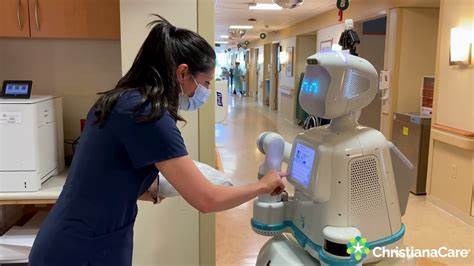Elmhurst Hospital in Chicago has a new employee. They’re five feet tall, have big blue eyes, and answer to the name of Moxi. They assist with various non-clinical tasks, such as delivering equipment and supplies, and are designed to save nurses valuable time on the job.
These collaborative robots, or cobots, are currently being used in 11 inpatient units, working alongside more than 400 nurses, at several hospitals all over the country, including three in Chicago and one in Pennsylvania. Many industries are experimenting with automation, but Moxi has proven to be especially effective amid the ongoing nursing shortage.
“With the staffing shortage, we’re always looking for ways to take non-clinical tasks away from the clinical staff, especially repetitive tasks,” said Dr. Kimberley Darey, Elmhurst chief medical officer.
Moxi doesn’t work with patients. Nurses and other staff members assign the robot tasks using an app on touchscreen devices, but patients often run into the wide-eyed machine when it’s roaming the halls.
“That’s technology these days,” said David Crisp, a patient at Elmhurst, laughing after seeing Moxi while he waited for his appointment. The robot had just rolled up to the infusion center to deliver medication to a nurse. “These are the times.”
When the robot makes a delivery or arrives for a pickup, the nurse will swipe their badge on a sensor that sits at around waist height. This allows the provider to open any drawer on the robot. The message, “Hello, I’m here for a drop-off,” appears on the machine’s face, replacing their eyes.
The two Moxis working at Elmhurst complete around 1,800 deliveries a month.
Jennifer Moore, a nurse manager at MacNeal Hospital in Chicago, said the robots have made a tremendous difference during these difficult times.
“At MacNeal, we have a lot of people moving supplies and equipment around,” Moore said. “Our nurses are leaving the floor, leaving their patients’ bedsides, to return (telemetry boxes),” she said. “Moxi was a great way to help keep those people in their departments and be able to still move the medications and equipment and supplies from point A to point B.”
“I grew up with ‘The Jetsons’ and Rosey (the robot),” Moore added. “I think it’s really exciting.”
Heather Johnson, a nurse and clinical leader at the hospital, admits some of the nurses were nervous when Moxi first joined earlier this year, but they quickly grew to appreciate the added efficiency.
“If we didn’t have Moxi, then that means nurses are running off the unit themselves,” Johnson said. “As nurses, we want to be with our patients at all times.”
According to a study published in the Journal of Nursing Management, nurses spend up to 33% of their shifts on repetitive tasks, such as picking up and dropping off medications.
“Nurses need the time and space to deliver excellent care and patient education to the fullest extent of their training and experience,” said Ric Cuming, chief nurse executive and president, ChristianaCare HomeHealth, which started using the robot in May. “Moxi will be doing those hunting and gathering tasks such as getting equipment and supplies, which nurses are doing today but don’t need to be doing at all.”
“Moxi is not a replacement for a nurse or nursing position — or any position,” Cuming explained. “It is an additional resource for nurses and their teams. “With robotic technology, we are using resources wisely and effectively, creating more efficient workflows, reducing repetitive tasks and freeing up nurses’ time for the complex clinical work that they excel at doing.”
Pam Owen, nurse manager on one of the pilot units using Moxi said, it’s been a delight to have the robot on board with so few nurses on staff. “It’s absolutely in the best interest of our patients that Moxi can work alongside nurses so we can spend more time working directly with our patients to do what we do best,” Owen said. “And Moxi brings a smile to people’s faces.”
Post Views: 309







